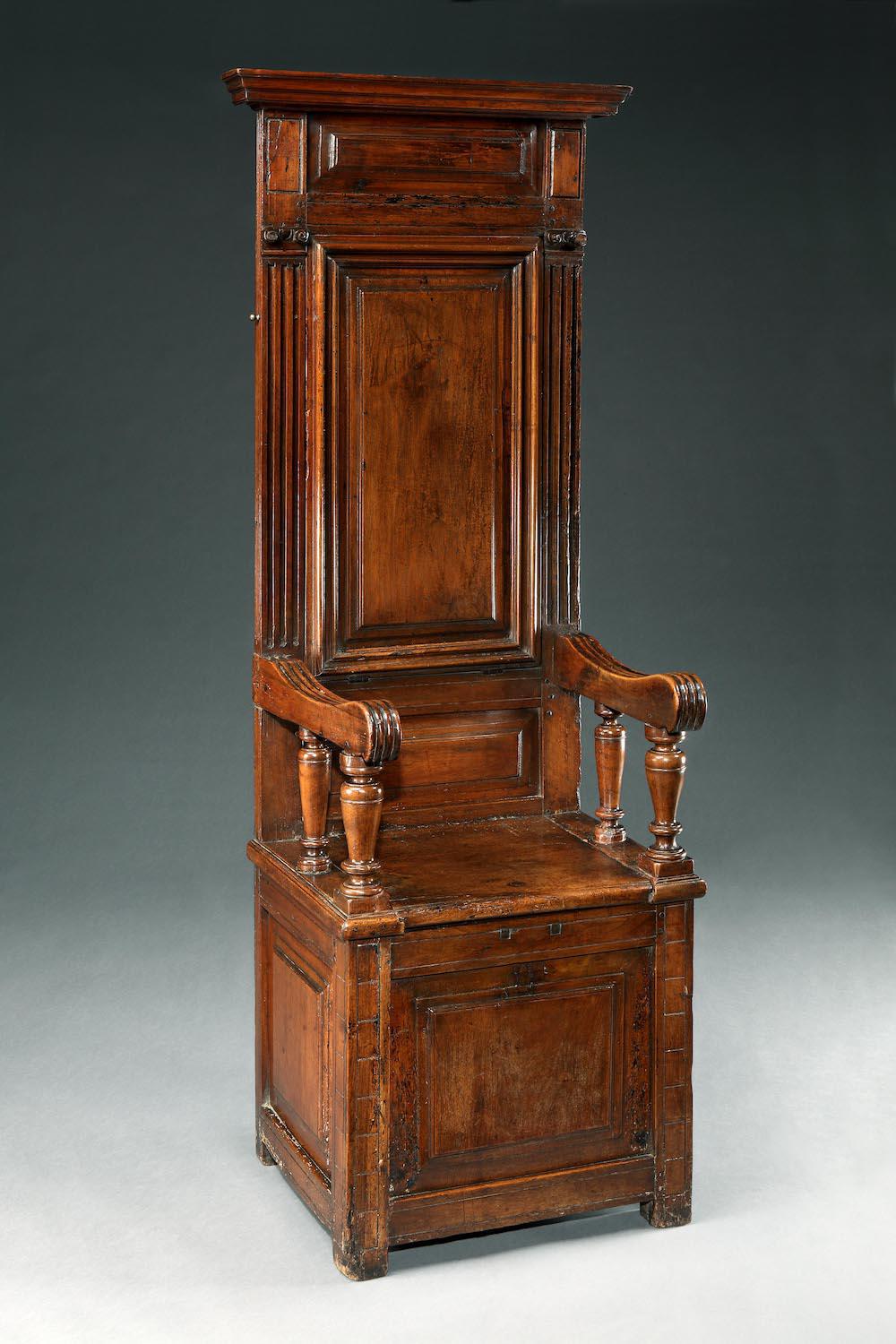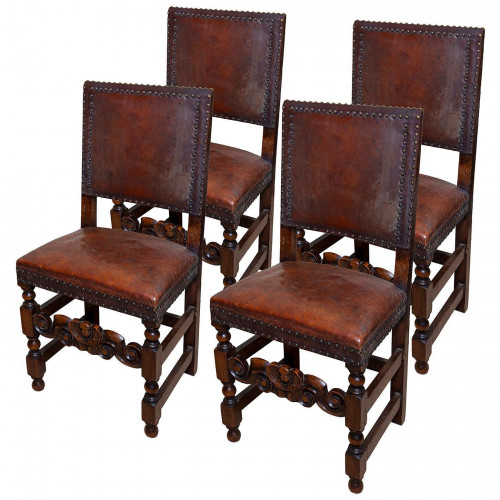Cathedra or Throne Chair, Late 16th Century, French Second Renaissance, Walnut
11208
A moulded cornice sits above the high, panelled back with fluting and applied roundels. The later, metal pin on the left edge releases the central, moulded panel in the back which retains its original hinges. When the pin is removed the panel can be lowered, revealing a large area behind. The scroll arms are supported by tapering turnings which can be compared with mid-16th century benches of the nave such as those in the churches in Gerberoy and Coivrel which are in Oise, the Piccardie region of Frances.
The panelled, box seat has later 18th century hinges which reveal a large, compartment and the lock has been removed. The front stiles are decorated with a carved, geometric motif which is derived from architectural design and is found on furniture of this calibre from this epoch. Old worm damage and minor losses. Henri II.
This type of chair was made from the 15th century, and can be seen in the Musee des Arts Decoratifs, and cathedrals in France. This cathedra displays the rigid structure of a chair of honour according to the Gothic system, full panels, high back and hinged box seat but the scroll arms and tapering turnings date it to the Second Renaissance. See No 123 which has similar shaped arms and turnings ; chaire a haut dossier bois de Noyer, France, seconde Renaissance ver 1560-1570, collection privee, (Le Mobilier Francais du Moyen Age a la Renaissance, Jacqueline Boccador).
Measures: Back height 205 cm., 80 ¾ in, seat height 62 cm., 24 ½ in. Cornice length 75 cm., 29 ½ in. Length 64 cm., 25 in., depth 49 cm., 19 ¼ in., Inside panel opening length 46 cm., 18 in., height 84cm., 33 in.,
Provenance: PROVENANCE : Private collection along with a walnut, centre table with slate inset from the same period.
RELATED TO : No 122, cathedre ecritoire, bois de Noyer, Bourgogne, époque Henri II, vers 1560-1570, collection privee, (Le Mobilier Francais du Moyen Age a la Renaissance, Jacqueline Boccador), which also has a hinged back panel. Le mobilier picard 1200-1700, Laurence Fligny, ed Picard, 1990, discusses the benches of the nave in Gerberoy & Coivrel.
Exhibitions: The opening back panel is an ingenious device for concealment as it is not visible from the front or obvious. I only know of one other chair with this feature which is illustrated in Boccador no 122. The original pin was most likely a wooden peg which would appear as part of the structure of the cathedra. When this long, pin is removed the panel can be lowered, revealing a large area behind. We can therefore conclude that this cathedra was made with the intention of concealing and giving access to object/s of great value or importance such as a religious or political iconography which tended to be bound together.
The 'cathedra' was originally associated with the Catholic Church where it was reserved as the seat of the Bishop and placed against the wall of the apse of the church. It is possible that this 'cathedra' was made for a church or monastery where the panel could have been used to conceal items like documents, charters and relics. However these would have been kept inside a container which would need to stored within a recess in the wall behind. Given that the back is roughly finished with no evidence of being used as a table, does not have any mechanism to support it when lowered and that the hinges are original, I do not think that the secret panel in the chair was conceived with this in mind or that it has been used in this way. If this was the case it would be much easier to move the chair to get access to a box hidden in a recess behind.
There is evidence of such chairs in a secular context where it could have been placed in a private chapel or in the main receiving room serving as a seat of honour for the owner of the house, most likely a nobleman. The restrained ornament on the cathdra also indicates that it is possible it was conceived as a secular piece. It would make more sense that the panel was conceived to hide either a painting or iconography, which could have been religious/political, on the wall behind which was very private and personal to its owner. He may have not needed to see or have regular access to it which is why a support was not made for the panel when lowered and why the original hinges survive. Maybe the fact that he knew it was there as a private manifestion of belief or standing was sufficient. There is archeological evidence in England of religious, wall paintings of similar size which do not bear any relation to the decoration of the rooms they were found in, so it is possible that this occurred in France also. I am in the process of researching this as it is very exciting to be able to produce a piece of furniture that could have been used in this way.
If we look at the context in which this cathedra was made this makes more sense. It was made at the time of the French Wars of Religion (1562-98) which was a period of civil infighting and military operation primarily fought between French Catholics and Protestants. The conflict involved the factional disputes between the aristocratic houses of France, such as the House of Bourbon and House of Guise and both sides received assistance from foreign sources.
Whilst the great majority of the country remained faithful to Catholicism, an important minority joined the Reformation. Coexistence of the two faiths throughout the Kingdom showed itself to be impossible, civil tolerance failed and war was unavoidable. Members of the nobility and even the Royal families converted to Protestantism at different points and led battles against Catholic equivalents. The exact number of wars and their respective dates are the subject of continued debate by historians, some assert that the Edict of Nantes in 1598 concludes the wars, although a resurgence of rebellious activity following this leads some to believe the Peace of Alais in 1629 is the actual conclusion. It was in Nantes, in April 1598, that Henri IV signed the well-known edict putting an end to the wars of religion that had ravaged France for some 36 years. This edict is more complete than the preceding ones. It established a limited civil tolerance and inaugurated religious coexistence. The Reformed service of worship was authorised in all placed where it existed in 1597 and access to all offices was guaranteed to Reformed Protestants.
So it is conceivable that this cathedra was made with a secret, hinged panel in the back to allow its owner, most likely a nobleman, to hide the symbols of his true faith rather than as a piece for the Church itself. Interestingly, Oise which is close to Paris was once home to kings and noblemen who left their mark in the many chateaux, abbeys and cathedrals. The owner of this chair may have been in a position where it was necessary to show his loyalty to Catholicism outwardly but privately his beliefs may have been very different. For example, in England Thomas Howard, 14th Earl of Arundel converted to Anglicanism in 1616 but remained loyal to Rome, the home of his noble family's religion. Whilst the Cecils associated themselves with the Reformation during their 16th century rise to power, they remained both politically and religiously conservative.
In France, protestants were exposed to harassment and persecution, and certainly hid incriminating objects such as bibles and books of psalms, in all kinds of caches designed for this purpose. They are known to have used mirrors to hide bibles (cf. Musée Desert, Mial, Gard) and the back of paintings, underneath seats, under double/false bottoms, underneath floor boards, and niches carved into the walls as hiding places. Communion coups were carried disassembled in several components. They also printed very small print Bibles called 'Bibles in a bun' that women hid in their hair !
Literature: This Cathedra is an example of excellent craftsmanship executed in walnut. Pieces of furniture, particularly from this period, that were conceived to be objects of disguise and concealment are exceptionally rare, and tend to be in cabinet form. We will never know for sure what the panel was designed to conceal but it is a wonderful evocation of the history, dangers and intrigue of the period in which it was made.
16th Century
1550-1600
Walnut
France
Collectors
Renaissance (Of the period)
Joinery
EXCELLENT
1
























